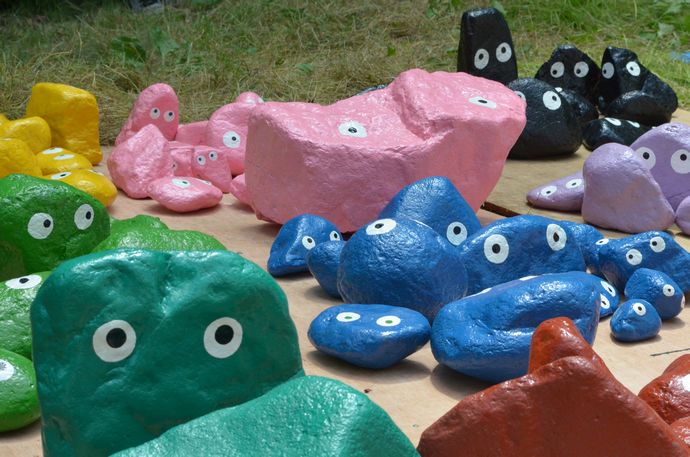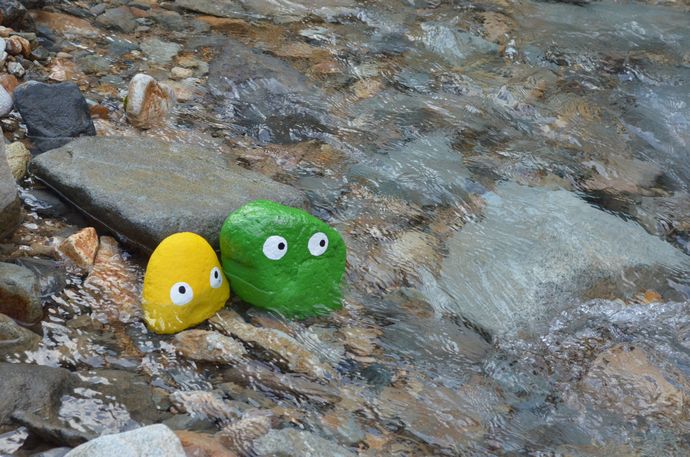A Real Rock Star
- 5月 1, 2018 ● From Fujirockers.org, Interviews

Gon-chans ready to be released into the wild
For almost everyone who arrives at Fuji Rock, one of the first unusual sights they may come across is a number of large boulders and rocks painted in bright primary colours, sporting expressions that seem quizzical, melancholy, surprised or thoughtful, among a range of other emotions you could project on to them. Scattered throughout the Fuji Rock festival site, the stony brood of Gon-chans, as they are known, have long been a fixture of the fest. Their creator, Gordon (Robert Gordon McHarg III), is a London-based artist who has worked closely with the festival for over a decade as well as the Joe Strummer Foundation and many more projects.
 “Gon-chan is my nickname given to me by Masa [Fuji Rock founder], so the Gon-chan family is based on that,” says Gordon when I chat with him over a beer in a noisy izakaya in Shibuya. “Masa and I have been friends since the 1990s, and I’ve been doing Fuji Rock for twelve years. I always used to help out with the artwork for Fuji Rock and one year I decided to paint Fuji rocks. I was going to paint these little characters. The whole Fuji Rock thing is that everyone is an individual, and no two rocks are alike, so it’s creating a community referencing the festival. It grew from that first year to doing it a second year, and a third year…”
“Gon-chan is my nickname given to me by Masa [Fuji Rock founder], so the Gon-chan family is based on that,” says Gordon when I chat with him over a beer in a noisy izakaya in Shibuya. “Masa and I have been friends since the 1990s, and I’ve been doing Fuji Rock for twelve years. I always used to help out with the artwork for Fuji Rock and one year I decided to paint Fuji rocks. I was going to paint these little characters. The whole Fuji Rock thing is that everyone is an individual, and no two rocks are alike, so it’s creating a community referencing the festival. It grew from that first year to doing it a second year, and a third year…”
Starting off that first year with 200 rocks, the number varies with each festival, with around 400 rocks scattered about the Naeba site, some daubed in gaudy colours, while others remain gloriously nude.
“I base it on Jyunji’s batting average,” says Gordon, referring to friend Jyunji Ikehata of Japanese punk rock band The Roosters. “He’s in my [baseball] team, so I ask him his batting average, and he’s usually over 360.”
All Gon-chans are sourced locally each year and painted by a team of volunteers during the festival.
“When I started, I wondered whether I would have to buy rocks. So I asked – anyone who wants to do it should ask. When I arrive, I pick them and paint them and then return them. Given the nature of where we are, there will always be more.”
However, in recent ye ars, Gon-chan sightings have become less frequent, owing to the rock’s popularity as a souvenir to take home. Last year there were some complaints that people were stealing Gon-chans, so I asked Gordon his thoughts on this:
ars, Gon-chan sightings have become less frequent, owing to the rock’s popularity as a souvenir to take home. Last year there were some complaints that people were stealing Gon-chans, so I asked Gordon his thoughts on this:
“Some bands gets rocks, some are given as gifts. Now, the ones in the river you may or may not see depending on what day of the festival it is. Nowadays, they get adopted earlier than usual.”
Adopted or stolen?
“When we first started, I said that I would go and pick them up after the festival as I didn’t want to leave them there as an eyesore, so we used to pick them up, but some were taken. Then we started to ask people to take them on a Sunday. In the last couple of years they have been adopted earlier. We always ask people to take them, so it’s not stealing, but as they have become more popular…”
The rock’s popularity is certainly widespread, perhaps because it has a peculiarly magnetic character. You can often see people admiring Gon-chan on their way between stages, and some have commented that the rocks help them to take in and enjoy their surroundings more.
“That’s an awfully nice thing to hear as it is about connecting with where you are,” replies Gordon upon hearing this. “We are blessed to be in such a beautiful location. Yes, the festival is about music, but it’s also about connecting with people, and I think Gon-chan does seem to have an interactive element. When I’ve passed by and seen people around him, they’re playing with him, having their photograph taken, so that can only be positive.”
 For those not quick enough to nab a real Gon-chan (and, really, do you need to carry 2kg rock home in your rucksack?), there is an alternative. In collaboration with Ganban, you can get your own (lightweight) Gon-chan to take home. Previous years have seen backpacks and key chains available to purchase, and this year you can treat yourself to a Gon-chan hat and a rock-shaped bean bag pillow – perfect for keeping the sun off your face, or taking a nap on the grass at the Green Stage while you wait for the next band to come on.
For those not quick enough to nab a real Gon-chan (and, really, do you need to carry 2kg rock home in your rucksack?), there is an alternative. In collaboration with Ganban, you can get your own (lightweight) Gon-chan to take home. Previous years have seen backpacks and key chains available to purchase, and this year you can treat yourself to a Gon-chan hat and a rock-shaped bean bag pillow – perfect for keeping the sun off your face, or taking a nap on the grass at the Green Stage while you wait for the next band to come on.
With a plethora of rocks at his disposal and more festivals to come, I ask what Gordon has in store for Gon-chan in the future, both the rock and the “real rock star”.
“I’ve had so many great experiences in Japan. I feel very inspired by Fuji Rock and love being part of the Fuji Rock family. As an artwork, a concept, I’ve had a few Gon-chan exhibitions in the UK and I hope to carry on doing more.”
So, make sure to check out the Gon-chans you see about the Fuji Rock site: take a photo with them, give the boulders a hug, rest your aching feet on one, take a dip in the river with them, and think about leaving them for others to enjoy… well, at least until Sunday.
Text: Laura Cooper
Gon-chan Photos: (Rocks) 近藤英梨子 and (Human) Ryohei Maruyama



